- Beetle beetle
- Museum Kozheed
- Leather-larvae
- Kozheed Smirnova
- Leather-bite bites
The beetle beetle belongs to the order of beetles. It is represented by more than 600 species, many of which are pests of food supplies, herbariums, exhibits of museums, libraries. In the last decade, skin-beetle beetles are increasingly found in apartments and some species have become synanthropic insects.
Appearance and living conditions
Kozheedy ubiquitous, except for the tundra. About 40% of the species are hazardous pests. They prefer a dry and warm climate, but feel good in heated rooms. The following species of skin-eating beetles are common on European territory:
- motley;
- museum;
- bumpy;
- Smirnova;
- carpeted;
- brown.
Food plasticity, the ability to do without food for a long time, the high activity in its search led to the fact that some species became synanthropic insects.

The oval body of the beetle has a convex back and is somewhat flattened from the ventral side. Hard elytra painted in masking colors from light brown to black. Dimensions are small, depending on the type of insect, vary within 1.3-12 mm.
The most common types of skin eater are easy to identify in appearance:
- Carpeted leather eater - a tiny brown bug that, due to its tiny size, can feed on small organic debris - pet hair, epidermis scales, food crumbs.
- Kozheed Smirnova - insect not exceeding 3 mm. Has a brown oval body. Beetle damages meat, dried fish, wool, linen, synthetic fabrics, paper. Larvae of middle and older age are especially harmful.
- Spotted Kozheed - larger than those listed above. The dimensions of the body of the beetle vary from 5 to 10 mm. It feeds on organic and inorganic foods. Used in forensics to establish the age of the corpse and thoroughly cleanse the bones of the remnants of the flesh in museums.
The surface of the elytra has outgrowths in the form of hairs and scales. In species with variegated coloration, the color is due not only to the pigment of the chitinous cover, but also to the color of the hairs. Some leather-eaters have yellow or red elytric constrictions.
The head of the beetle is firmly pressed to the chest and directed downward or straight. The antennae are club-shaped, consisting of a different number of segments (4-11), attached to the edge of the forehead. The beetle can hide them in the groove on the cheeks, like a carpet beetle or in the recesses located on the sides of the prothorax (at the museum bee-keeper).
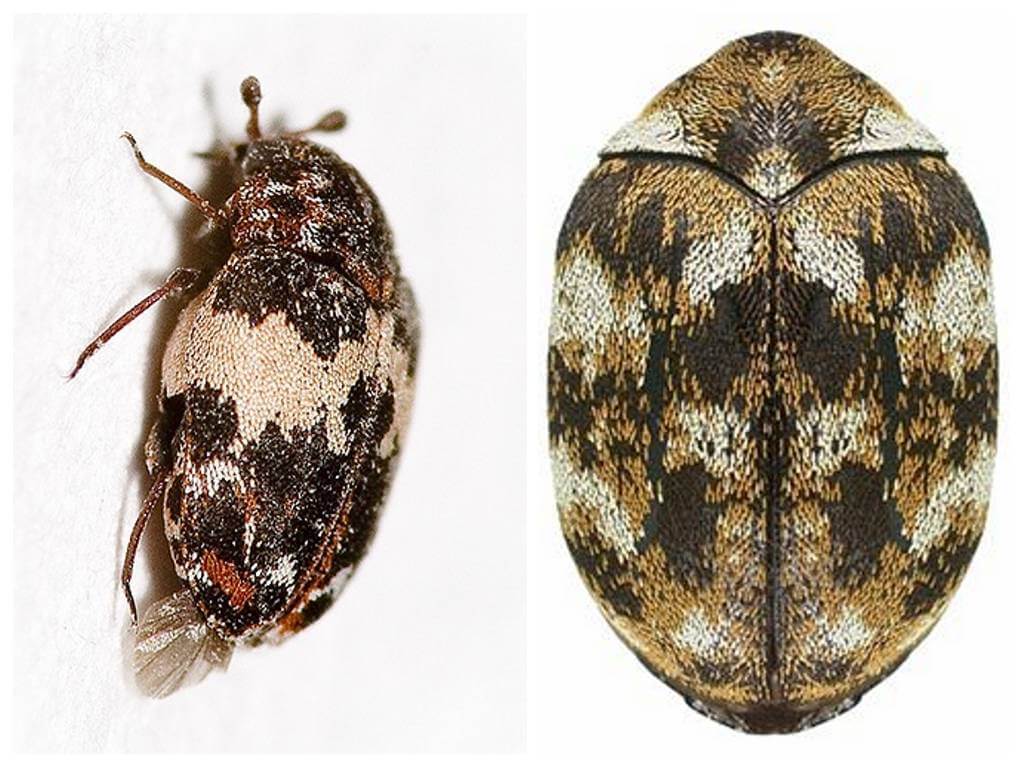
The eyes of the beetles are small, faceted. Facets are flat. A distinctive feature is the presence of a simple eye, which is located on the forehead. The skin-beetle bug compensates for not very good vision with a developed sense of smell. Attractants for some types of skin-eaters is the smell of umbrella plants and food substrate.
The paws of the beetles are five-segmented. On shins there are spurs, spines, hairs.
Sexual dimorphism is noted - in males, the antennae of the tendril is more pronounced and there are abdominal glands. During the summer period, a mottled skin-beetle, carpet-skinned bee-eater, museum and noric horsetail are found in large numbers on the flowers of plants of the Rosaceae or Umbrella family.Adult insects of many species of skin-eaters absorb the juice and pollen of plants or do not eat at all.
The mouth apparatus of the gnawing type in different species of beetles is represented by small mandibles of various degrees of development and structure. Most of the wings are well developed and at rest completely hide under the hard chitinous elytra.
Skin beetle beetles can be found in bird nests, small animal burrows. Some species are necrobionts and eat corpses of mammals, lizards. Cases of cannibalism have been noted.
Interesting!
All beetle species have a thanatoreflex. In case of threat or irritation of the surface of the body, the beetle presses its paws and antennae, turns on its back, pretending to be dead. If the irritation is severe, then the skin-eater can be in a state of stupor for 50-120 seconds. In some species, dissecting coloring is noted.
Adult beetles are not afraid of sunlight, and most have round-the-clock activity, increasing in the morning and evening hours.
What do larvae look like?

The larva of the skin-beetle beetle is worm-shaped with pronounced hairs of different lengths on the body and a brush of straight hard hair on the last segment. The larva actively eats, damaging all types of organic substrate - wool, hair, feathers, skin, cereals and grains, sausages, milk powder, etc. Gastronomic preferences are not limited to organics. In the absence of the usual food nearby, it can eat synthetic materials. Larvae move quickly and actively. Prefer to settle in a fleecy, rough fabric.
The skin-beetle larva does not like light, which is explained by the lack of chitinous cover and the imperfection of the water retention mechanism. At the first time after exiting the pupa, negative phototaxis is also observed in adult skin-eaters, since there is still little melanin in the chitinous cover, which protects against ultraviolet rays.
The body of the larva is oval, spindle-shaped. The legs consist of 5 shortened segments. Claw merges with leg segment.
The entire body of the larva is covered with hatets of various types, lengths and colors, represented by:
- by hairs;
- setae;
- flakes.
The photo of the skin-beater Smirnov shows an adult and larvae at different stages of development.
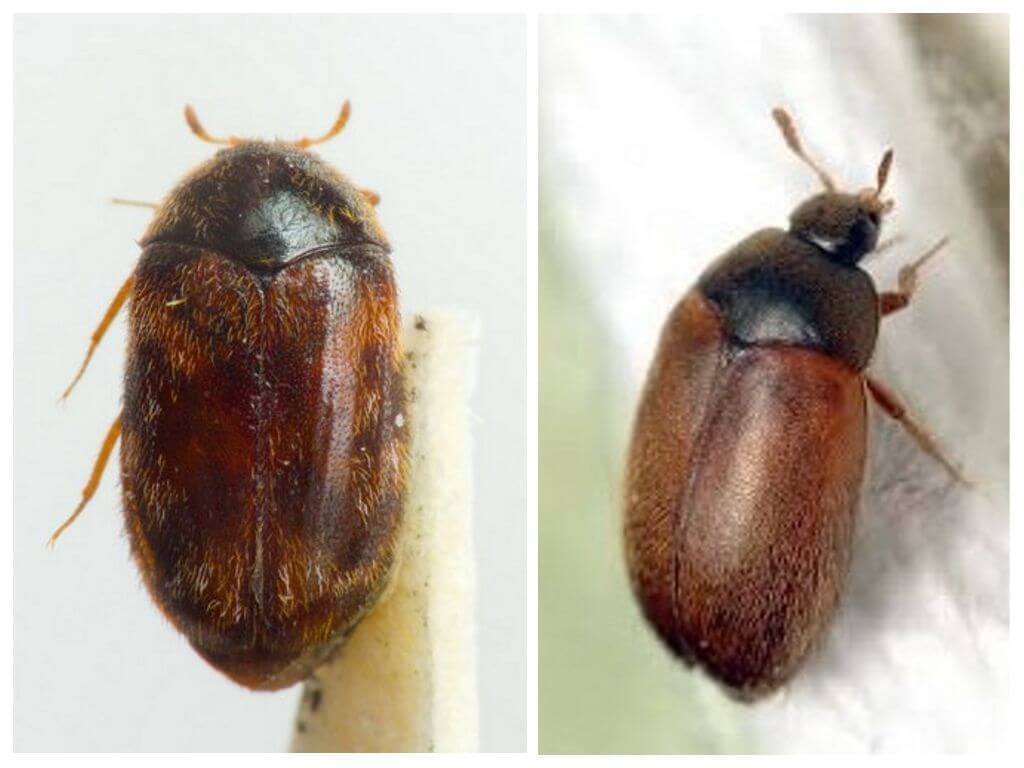
An ovoid egg, covered with a dense shell, which gradually turns yellow. The larva developing inside is visible through the shell.
Reproduction and Life Cycle
Beetle eaters are full-cycle insects. After fertilization, the female lays eggs in small portions in hidden places: crevices, in the pile of tissues, on the bodies of dead insects. The ovipositor lasts from 2 to 10 days, after which the insect dies. One sexually mature female lays no more than 100 eggs for the entire period of her life.
Of these, depending on temperature and humidity, larvae come out after 2-55 days. They prefer places with low light or no light. Unlike adults, which are guided in choosing a partner and finding food for olfactory receptors, the larvae are guided by tactile sensations. Developed mechanoreceptors dictate the choice of the surface on which it prefers to be.
Actively moving and eating, the larva goes through several stages of molting. The conversion rate depends on temperature and humidity:
- If comfortable humidity varies in a significant range (40-90%), then the temperature comfort zone is much more rigid and amounts to 20-30 ° С;
- In case of temperature violation, the larva may be at rest for some time, which lengthens the larval stage;
- Before pupation, the motor activity of the beetle larva is reduced.
In some species of skin-eaters, the last peel of the molt bursts, and the pupa remains in it. For others, it is completely reset. An unprotected cocoon the larva gnaws a passage ending in a chamber in which it undergoes a transformation process.Some pupae gnaw out the pupation chamber even in plaster, bone, concrete. The pupal stage lasts from 4 days to 20 days. After the completion of metamorphosis, the young beetle is still in the cell for some time and leaves it only after 2-3 days.
In most species of skin-eating beetles, the entire life cycle is 1 year, but under adverse conditions it can last up to 2 years. The larval stage is longer in duration than the adult's life span.
Interesting!
Even within the same offspring under favorable climatic conditions and the availability of food, a metamorphosis cycle of different lengths is noted. What is the reason, scientists can not say for sure.
In each generation of skin-eating beetles, up to 4% of larvae are found which, even with a sufficient amount of food, do not remain in one place, but crawl further, spreading the infection.
What is the danger of skin-eaters to humans?
Those who have come across a skin-beater, and especially its larva, cannot say that the “acquaintance” is pleasant. In places of infection, the insect leaves not only a spoiled thing or food, but also the smallest peas of excrement, skins after molting. All this can cause an allergic reaction.
The presence of pathogenic microbes on washes from the chitinous cover and inside the intestine was not detected. Although this issue is still being studied. It is allergens that are dangerous to humans.
The skin-bite bites were not confirmed, but it is possible that in some cases the larva can bite. People complain of typical symptoms. Local damage appears on the skin of a person, causing hyperemia, swelling, itching. Doctors tend to consider this a reaction of the body to a foreign protein in the form of dermatological manifestations, and not the result of a bite. They will not bite living flesh. The skin of a person is not of interest to them. The skins and dense media of the larva are used as an object to create a pupation chamber.
Ways of penetration and methods of struggle
During the summer, beetle-skinned beetles enter the apartment through open doors and unprotected windows. Items and food contaminated by insects can also become a source of colonization of the apartment by skin-eaters. The reasons for the appearance of insects in the apartment are different. To get rid of a pest at home:
- do a spring cleaning;
- check stocks of products and things from leather, fur, natural fabrics.
To find out where insects come from in an apartment, you should carefully check the cereals, crackers, and flour purchased by weight. Carefully inspect the herbariums, zoological collections.
How to deal with a pest:
- Before deciding how to get rid of a skin-beater in an apartment, you need to find places where the largest number of bugs and larvae are noted. The skin-bearer larvae hide in the pile of the carpet, in the crevices and under the baseboards of the house.
- Before hatching larvae in kitchen cabinets, clothes, furniture, you must first clean all things from pollution, get rid of spoiled by bugs products, papers, books. Wet cleaning and a vacuum cleaner will help fight pests that have infected the house.
- Low temperatures (below 12 ° C) prevent skin eater infection. To remove the skin-eater, freezing is used for 8-10 hours at a temperature of -15 ° C.
- An effective means of combating beetle larvae should be to treat all places of their intended localization with boric acid powder. The substance must be scattered in secluded places where larvae may appear.
Breeding insects with folk remedies is a more gentle method and does not require large financial costs. Boric acid denatures the proteins of unprotected chitin larvae, getting into the intestines of adult beetles, causing their death.
It is recommended to use dusts and solutions of insecticides, aerosols against synanthropic insects. Repellents in the case of combating skin-eaters are useless. Pest control staff can advise the most effective drug, depending on the type of bug.Processing is carried out taking into account the physiology and life cycle of the skin-eaters.
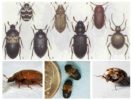
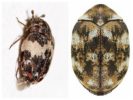

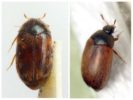
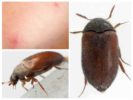
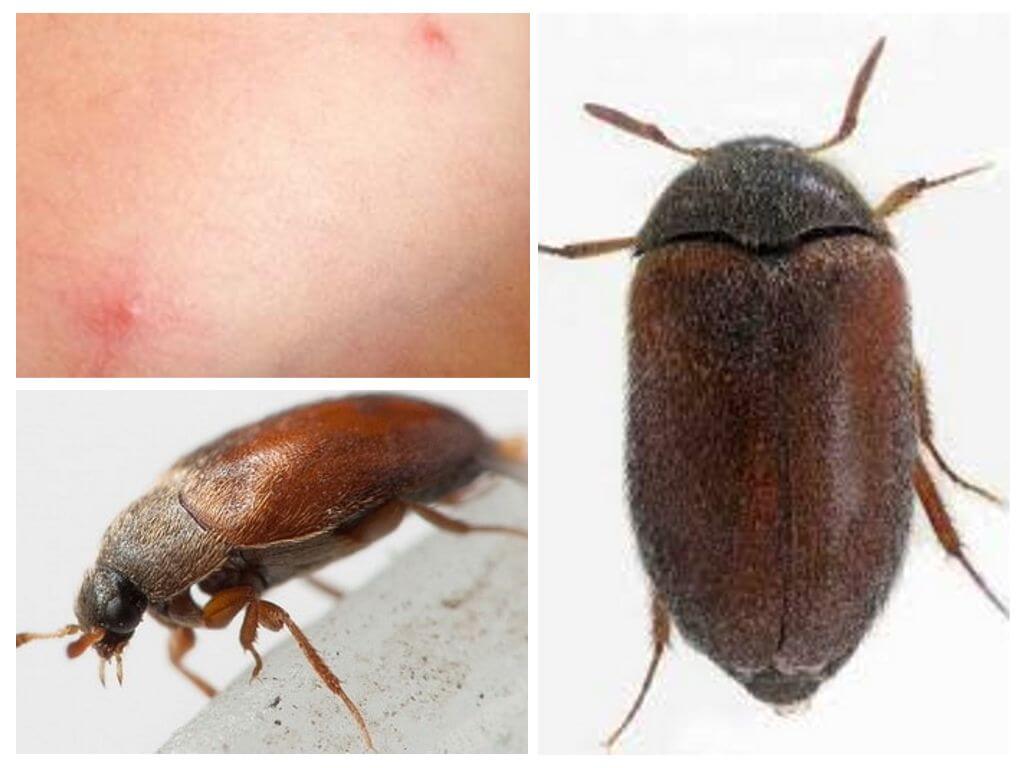




I got small bugs in the croup. I bought pearl barley by weight and in a couple of days they scraped into the kitchen drawer. I threw out the cereals and washed everything with vinegar, and then I also hung special sachets for the bugs.
And are you sure that they were leather-eaters?
It does not matter, the main thing is that a person got rid of pests without any chemistry.
My skin-eaters wound up in the old herbarium. From the time of college, he was lying on my mezzanine. And recently he climbed to get old notes and was horrified - everything was eaten up in dust. Popshikal Dichlorvos and they all died.
I heard about boric acid more than once. Her ants, and cockroaches poison. It is said to be a very good and safe remedy. I haven’t tried it myself, because so far the skin-eaters haven’t touched me.
I believe that it is better to use insecticides. Moreover, now they are full in stores. Why fool your head with different folk remedies! While you wait for the effect, the beetles will divorce even more.
I breed rabbits. I decided my wife to pick up skins on a vest. While collecting - two skins gobbled up by skin-eaters. I deduced that it is best to treat with acid - the skin-eaters cannot tolerate acid. I don’t know what will happen. Has anyone tried it?
I bought an old book from a second-hand book dealer - I really needed it for work. It turned out that, along with the acquisition, he brought small dark bugs to the house. Barely got rid of adversity!
The leather-eaters spoiled my stuffed birds, which we did with the late father. I’m saving them, as a memory, but I had to throw everything in the trash and still process the apartment with Raid twice.
After reading the article, I immediately ran to the closet. My only fur coat is hanging there. I put it in a vacuum bag. I hope that if there were skin-eaters, then without oxygen they will quickly die out!
You are naive. They will eat your package (